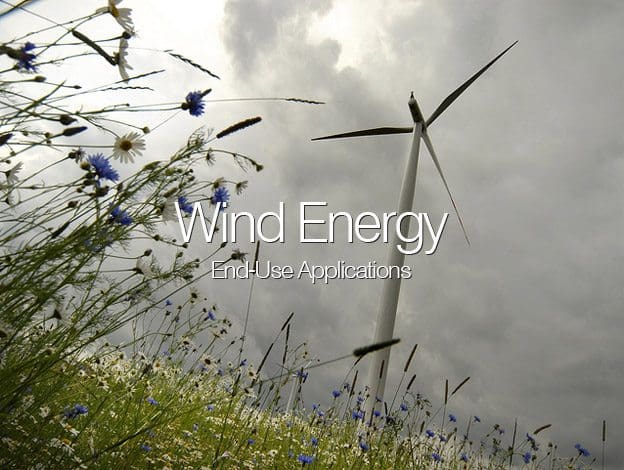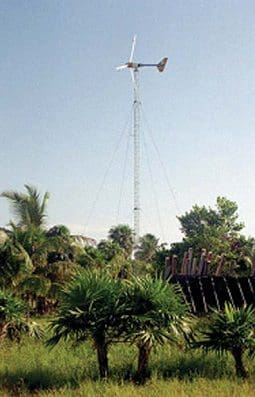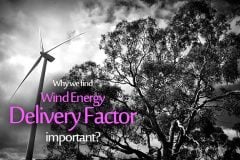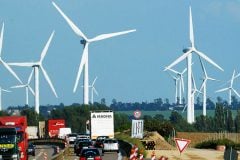
Markets
Wind energy markets can be classified based on the end-use application of the technology. Wind energy projects are common for off-grid applications.
However, the largest market potential for wind energy projects is with on-grid (or grid-connected) applications.
Off-grid applications
Historically, wind energy was most competitive in remote sites, far from the electric grid and requiring relatively small amounts of power, typically less than 10 kW.
In these off-grid applications, wind energy is typically used in the charging of batteries that store the energy captured by the wind turbines and provides the user with electrical energy on demand, as depicted in Figure 1.
Water pumping, where water, rather than energy, can be stored for future use, is also a key historical application of wind energy. The key competitive area for wind energy in remote off-grid power applications is against electric grid extension, primary (disposable) batteries, diesel, gas and thermoelectric generators.
On-grid applications
In on-grid applications the wind energy system feeds electrical energy directly into the electric utility grid.
Two on-grid application types can be distinguished.
- Isolated-grid electricity generation, with wind turbine generation capacity typically ranging from approximately 10 kW to 200 kW.
- Central-grid electricity generation, with wind turbine generation capacity typically ranging from approximately 200 kW to 2 MW.

Isolated-grids
Isolated-grids are common in remote areas. Electricity generation is often relatively expensive due to the high cost of transporting diesel fuel to these isolated sites. However, if the site has good local winds, a small wind energy project could be installed to help supply a portion of the electricity requirements.
These wind energy projects are normally referred to as wind-diesel hybrid systems.
The wind energy system’s primary role is to help reduce the amount of diesel fuel consumption. A wind-diesel hybrid system is shown in Figure 2.

Central-grids
Central-grid applications for wind energy projects are becoming more common.
In relatively windy areas, larger scale wind turbines are clustered together to create a wind-farm with capacities in the multi-megawatt range. The land within the wind-farm is usually used for other purposes, such as agriculture or forestry.
Another common approach for wind energy project development includes the installation of one or more larger scale wind turbines by individuals, businesses or cooperatives.
A windfarm, as depicted in Figure 3, consists of a number of wind turbines (which are often installed in rows perpendicular to the wind direction), access roads, electrical interconnections and a substation, a monitoring and control system and a maintenance building for the larger farms.
Construction involves the following:
- Preparing the site,
- Grading roads,
- Building turbine foundations,
- Installing the electrical collection lines and transformers,
- Erecting the turbines, and
- Construction of the substation and building.

The wind resource assessment and approvals for a windfarm are often the longest activities in the development of the wind energy project. These can take up to 4 years in the case of a large windfarm requiring a comprehensive environmental impact study.
The precise determination of the wind resource at a given site is one of the most important aspects in the development of a wind energy project as the available wind resource at the project site can dramatically impact the cost of wind energy production.
In the case where a pre-feasibility study indicates that a proposed wind energy project could be financially viable, it is typically recommended that a project developer take at least a full year of wind measurements at the exact location where the wind energy project is going to be installed.
Figure 4 shows the installation of a 40 m tall meteorologi-cal mast at the CANMET Energy Technology Centre – Varennes in Canada.

For very small-scale projects (e.g. off-grid battery charging and water pumping), the cost of wind monitoring could actually be higher than the cost to purchase and install a small wind turbine.
In this case a detailed wind resource assessment would normally not be completed.
Science in the City: Altamont Wind Farms (VIDEO)
Southeast of San Francisco, on the way out to California’s Central Valley, thousands of wind turbines dot the landscape of Altamont Pass. Mounted both in rows and individually, machines with large propellers catch the wind, turning round and round at different speeds.
Learn how wind energy is generated and stored for use in this most peculiar area, and its impact on living things both near and far.
Cant see this video? Click here to watch it on Youtube.
Resource: CLEAN ENERGY PROJECT ANALYSIS: RETSCREEN ENGINEERING & CASES TEXTBOOK – Canmet Energy Technology Centre











EXCELLENT TECH. ARTICLES THANKS LUIS
Thank you Luis!